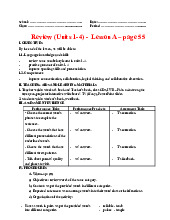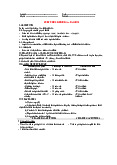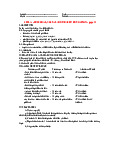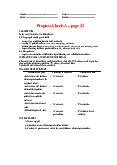



Preview text:
School: ………………………………………..
Date:……………………………………..
Class: …………………………….....................
Period: …………………………….........
UNIT 3: GLOBAL WARMING AND ECOLOGICAL SYSTEMS
Progress Check A – page 34 I. OBJECTIVES
By the end of the lesson, Ss will be able to:
1.1. Language knowledge and skills
practise asking and answering about a visit. practise test-taking skills.
write a letter to describe a visit. 1.2. Competences
improve communication, collaboration, logical thinking, and collaborative discussion. 1.3. Attributes
be aware of beauty of nature and how to deal with family problems.
II. TEACHING AIDS AND LEARNING MATERIALS
1. Teacher’s aids: Student’s book and Teacher’s book, class CDs, IWB – Phần mềm tương tác trực
quan, projector/interactive whiteboard / TV (if any), PowerPoint slides.
2. Students’ aids: Student’s book, workbook.
III. ASSESSMENT EVIDENCE Performance Tasks Performance Products Assessment Tools - Rearrange the sentences to - Ss’ answers. - T’s feedback. form a meaningful dialogue. - Interview partners about a - Ss’ pair work. - T’s observation & visit. feedback. -
Read the passage and decide if - Ss’ answers. - T’s correction. the statements are T or F. - Listen and choose the best - Ss’ answers. - T’s correction. answer. -
Write a letter to a friend to tell - Ss’ answers/ - T’s feedback/ Peers’ him/her about a visit. presentation. feedback. IV. PROCEDURES A. Warm-up: (5’)
a) Objectives: review different pronunciation features.
b) Content: Ss pronounce and choose the words that have different pronunciation.
c) Expected outcomes: Ss pronounce the words correctly.
d) Organization of the activity: TEACHER’S ACTIVITIES STUDENTS’ ACTIVITIES
Task a. Different pronunciation.
- Have Ss work in pairs to discuss and choose one word - Work in pairs and complete the task.
that has different pronunciation of the underlined part:
- Set the time limit for 2 minutes. - Call for answers. - Give answers. - Correct as a whole class. - Check answers.
1. a nnoyed – anxious – narrow – angry. Answer Keys:
2. worried – carried – enjoyed – escaped.
1. annoyed 2. 2scaped 3. tasted
3. tasted – showed – nagged – blamed.
Task b. Different stress patterns.
- Have Ss work individually to choose one word that
- Complete the task all by oneself.
has a different stress pattern from other words in a group:
- Set the time limit for 2 minutes.
- Call for answers and explanations. - Give answers and explain. - Correct as a whole class - Check answers.
1. argument – performance – attitude – citadel Answer Keys:
2. independent – historical – traditional – reliable-
1. performance 2. independent 3. etiquette
3. etiquette – cathedral – pagoda - attraction B. Main lesson (35’)
Activity 1: Speaking (7’)
a) Objectives: Ss can ask and answer questions about places.
b) Content: Ss work pairs to practise the conversation.
c) Expected outcomes: Ss can talk about a trip they took.
d) Organization of the activity: TEACHER’S ACTIVITIES STUDENTS’ ACTIVITIES Task a. Everyday English.
- Have Ss work individually to complete exercise 5 -
Complete the task all by oneself. (SB, p.34). - Call for answers. - Give answers.
- Check answers as a whole class. - Check answers.
- Let Ss work in pairs, ask and answer about a trip - Work in pairs to practise.
they took. They can use the dialogue as an example. - Call for presentation. - Give answers in pairs. - Give feedback - Listen to T’s feedback. Answer keys 2. It was incredible!
4. We visited an ancient temple.
1. How was your trip to Indonesia? 3. What did you do?
Activity 2: Reading (10’)
a) Objectives: Ss practise reading for specific information.
b) Content: Ss read and decide if the statements are true or false.
c) Expected outcomes: Ss can apply strategies to deal with task type true-false and learn some
vocabulary words about a tourist attraction.
d) Organization of the activity: TEACHER’S ACTIVITIES STUDENTS’ ACTIVITIES Task a. True or False? -
Have Ss underline key words in each statement in -
Highlight or underline the key words. exercise 6 (SB, p.34). -
Have Ss work individually to complete exercise 6 -
Complete the task all by oneself. (SB, p.34). -
Let Ss work in groups of 3 to share their answers. -
Check answers with their partners. - Call for answers. - Give answers. - Give correction. -
Listen to the teacher to check answers. Answer Key:
1. F 2. T 3. T 4. F 5. T
Activity 3: Listening (10’)
a) Objectives: Ss can practise listening for specific information.
b) Content: Ss listen and choose the best answer for each question.
c) Expected outcomes: Ss can confidently deal with multiple choice questions and gain some
vocabulary as well as ideas about family problems.
d) Organization of the activity: TEACHER’S ACTIVITIES STUDENTS’ ACTIVITIES
Task a. Listen and choose the best option. -
Have Ss underline the key words of each -
Underline or highlight key words.
question and make sure they understand all the options. -
Have Ss work in pairs to find some similar words - Work in pairs.
with the words in questions and options. - Call for answers. - Give answers. - Give feedback. - Check answers. -
Let Ss listen and choose the best option for each -
Work individually to complete the task.
question. Ask Ss to take notes on all the words or phrases they can hear. -
Call for answers and ask Ss to explain. - Give answers and explanations. - Correct as a whole class. - Check answers. Answer keys: Key words: 1. Megan’s problem.
2. What – Megan – want – do 3. Megan – feel – problem.
4. Colin – suggested – Megan. 1. B 2. A 3. D 4.C
Activity 4: Writing (10’)
a) Objectives: Ss can practise writing a letter and describing a place.
b) Content: Ss write a letter to an English friend to tell him/ her about a visit to a local attraction.
c) Expected outcomes: Ss know how to write a letter and can use learnt vocabulary in unit 2 to
describe a local attraction they visited.
d) Organization of the activity: TEACHER’S ACTIVITIES STUDENTS’ ACTIVITIES Task a. Write a letter. -
Help Ss revise the structure of a letter. - Listen to the teacher. -
Ask Ss to list some vocabulary learnt in unit 2 -
Write down all the possible words.
that can be used to describe a place or a visit. -
Instruct Ss how to write the letter. -
Listen to the teacher’s instructions. -
Have Ss work individually to write the letter -
Complete the task individually. (exercise 8, SB, p.34) -
Let Ss work in pairs to check one another’s -
Check their partner’s writing. letters. - Observe and give feedback. -
Listen to the teacher’s feedback. Sample letter: Hi Robert,
Hello from Vietnam. I just came back from a
wonderful visit to Huế City. It was the capital city of
Vietnam from 1802 to 1945 with the Nguyễn Dynasty
of emperors. It is an incredible historical place in Vietnam.
We first went to the Complex of Huế monuments and
visited the Imperial City. We learned about the life of
the emperors and the history of the city. I really
enjoyed exploring the Forbidden Purple City, where
only the emperor and his family were allowed.
Next, we went to visit Thien Mụ Pagoda. It is one of
the most famous pagodas in Vietnam with 7 storeys.
After that, we went for a walk along the Hương River
and tried some delicious local dishes from the street
stalls. The next day, we went hiking in Bạch Ma
National Park near the city. We climbed the park’s
highest mountain and saw an incredible waterfall.
Huế City is an amazing place! I wanted to stay more
and see all the interesting sites. It’s an incredible
history lesson. I can’t wait to tell you about it when I see you. Best wishes, Daryl
C. Consolidation and homework assignments (5’) * Consolidation
- Talk about a local attraction you would like to visit in the future. * Homework:
- Review the learnt vocabulary in today’s lesson and do the exercises in WB: page 23
- Prepare: Review for Term 1 Midterm Test. V. REFLECTION
a. What I liked most about this lesson today:
………….………………………………………………………………………………
b. What I learned from this lesson today:
…………………………………………………………………………………………
c. What I should improve for this lesson next time:
…………………………………………………………………………………………



